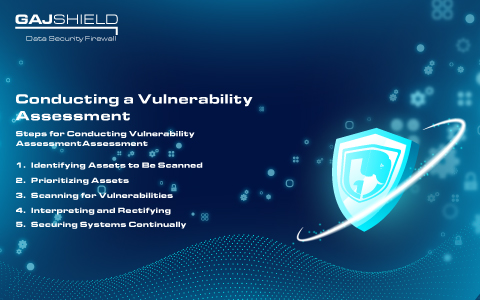Steps for Conducting a Vulnerability Assessment.
In the world of digitalization, the rise of cyber threats growing daily is not a new fact. Cyber attackers are getting more nuanced and advanced in the way they target a victim. Cybercriminals are always on the lookout for network weaknesses. If a company’s system has any weak spots, hackers can easily infiltrate it and disrupt the entire network and its operations. There are several company reports stating that their software was vulnerable to a cybersecurity attack. As of 2022, over 22,000 more IT vulnerabilities were identified, which is the highest figure till now. Therefore, no one is entirely safe from their attacks.

To mitigate this, businesses should take proactive steps to manage any vulnerabilities in their system and ensure their data security. To be proactive, the company’s IT should conduct vulnerability assessments.
Use of Vulnerability Assessment
A vulnerability assessment monitors and evaluates the strengths and weaknesses of a company’s systems and produces a detailed report on the security gaps. This report will further help companies take action to stop the attack from taking place and avoid any breaches.
Steps for Conducting Vulnerability Assessment
To protect data security, companies globally should be vigilant and conduct regular vulnerability assessments of their entire network. The steps for conducting the assessment include -
1. Identifying Assets to Be Scanned
The first step in conducting a vulnerability assessment is to identify what part of the system the company wants to scan. However, this isn’t as easy to figure out as it may seem because companies don’t have complete visibility of their entire security network and all devices connected. For example, employees have portable devices that they may connect and disconnect in a hybrid mode (office and remote). This makes keeping a tab on all connected devices difficult and also securing it. Therefore, automating the identification of weak spots in a company’s network can help streamline and target the required software.
2. Prioritizing Assets
After the company decides which part of its network they want to assess, they need to prioritize it based on the level of most to least likely vulnerable to threats or attacks. Therefore, companies need to be vigilant and proactive about their system. Many reports on vulnerabilities are available to everyone publicly; companies can access them and use them as a reference point by correlating them with their security touchpoints. They need to identify the software or files containing confidential information and ensure their data security. This allows for the most crucial areas of the system to be secured against potential hacking attacks.
3. Scanning for Vulnerabilities
The next step is to scan the networks for any potential cyber threats based on priority. Vulnerability scanners enable companies to identify security gaps and weaknesses and provide suggestions for their remediation. Vulnerability scanners can also extract useful information from published records of other companies in a similar industry and use them to locate looming threats on unsecured devices connected to the company’s system.
4. Interpreting and Rectifying
Once the scanning for vulnerabilities is complete, a detailed report will be generated to provide an assessment of the entire system’s security structure. It will share insights into two things largely. First is the severity of the risk that the scanner detected. Based on the threat's impact, the deployed solution should be categorized around it. However, this doesn’t mean that the touchpoint least likely to be attacked should be ignored. Hackers can also target various small security touchpoints that aren’t secured and can create destruction big enough to destroy the company’s standing.
The second insight provided will be on how much the vulnerability is exposed to hackers. Weak security on the internet or wireless network front can be easily infiltrated by any cyber attacker and should be prioritized. Employees’ portable devices with any outside software ridden with vulnerabilities should be rectified. Also, the company’s systems that record the maximum amount of confidential data should be secured to ensure data security and mitigate any adverse effects on their operations.
5. Securing Systems Continually
Even after conducting the vulnerability assessment and securing the exposed systems and networks, the company should continuously deploy it to prevent any present or future risks. For various reasons, a company’s system can be vulnerable even after taking the required steps after the initial evaluation. Attackers are always on the lookout for weak systems, and if they find a gap, it won’t take them long to breach it. Therefore, continually conducting vulnerability assessments will help create a robust security posture for the company.
In this digital era, where data is one of the most precious assets, hackers are on the hunt to exploit companies and gain benefits from their destruction. Businesses globally need to ensure that their entire system is protected to mitigate such scenarios. This can be done by conducting regular vulnerability assessments. It provides a detailed report on the areas that are potentially hackable based on their severity and exposure. It also generates suggestions for companies to help ensure their data security.
GajShield’s robust cybersecurity solutions, such as threat surface management, data leak prevention, application filtering, and many more, help to secure all security touchpoints and ensure optimum security. We ensure that our clients are secured from any threats looming over their systems. Contact us to learn more about our diverse solutions.
Get In Touch With Us
Subscribe to our Newsletter
2025 © GajShield Infotech (I) Pvt. Ltd. All rights reserved.
